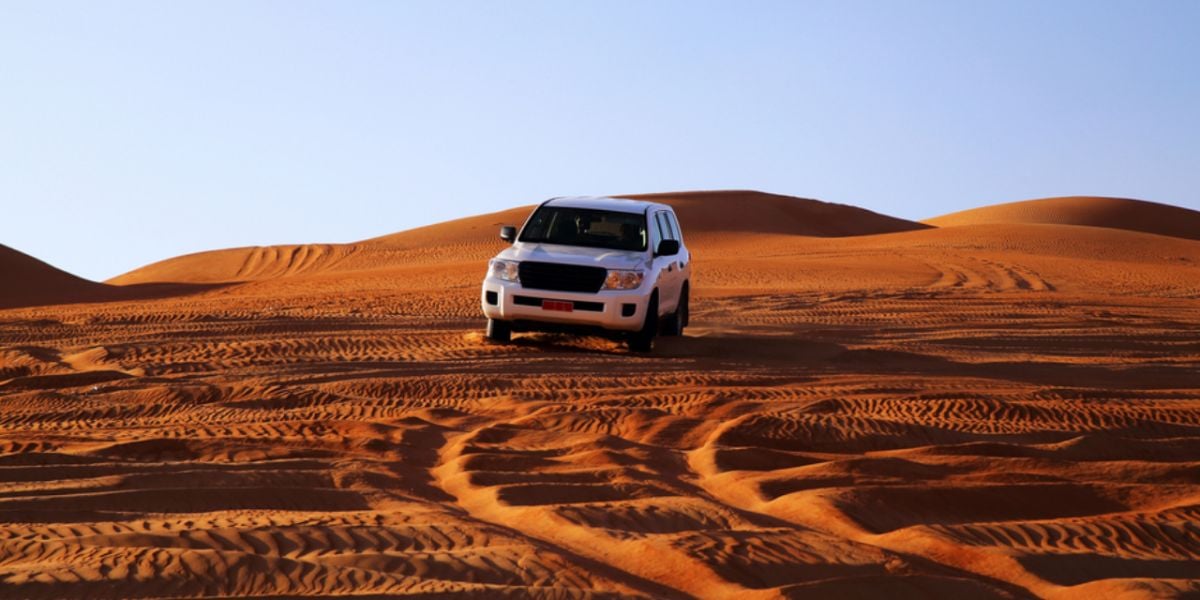
Expatriates tend to prefer to drive in Oman, as public transportation isn't fully implemented across the country yet. Moreover, many of them are not provided with transportation from their company, so they will have to commute daily to go to work. Depending on their position, expatriates are not always allowed to drive company cars, so they ultimately tend to buy one when they can afford it.
Obtaining a driving license in Oman
The minimum age for driving in Oman is 18 for both locals and foreigners. However, you will need to be 21 if you are only a visitor. If you are in the country on a visit visa and wish to drive during your stay, it is very important to know that you are only allowed to drive rental cars.
Good to know:
Visitors to Oman cannot drive a private car with a yellow plate or even a company car unless it is rented. Generally, the plate includes the letter TA. Depending on your home country, you might only need your original license, or you will need an international driving license.
Once you have your Omani ID card done, it is possible for certain nationalities to simply exchange their local license for an Omani one. Rest assured that they will always give you back your home country's license. If you are not eligible for the exchange, you will have to go through some local tests. The driving license for expats is only issued for two years.
Driving test
If you need to go through the Omani driving license test, you will first have to find a certified driving instructor and negotiate the rates until you pass the test. Usually, the instructor will offer you a package that includes a certain number of driving hours and the costs of the tests.
The first phase consists of the sign test, the parking test, and a slope-based test to make sure you can control the car. It is possible to choose between automatic or manual cars to learn to drive. The last stage will be directly with a police officer. He will assess your skills through a live road test.
Good to know:
It is very common for people who have been driving for years in their home country to fail the second phase several times, which increases the cost of the license significantly. We recommend that you familiarize yourself well with the Omani roads and traffic before taking the last step.
Once you have successfully passed all the requirements, you will simply need to have your eyes checked (OMR 5 to OMR 10) by an approved local optician while filling out the application form before proceeding to ROP to pay the fee and obtain your license (OMR 20).
Overall, obtaining a driver's license in Oman can cost around OMR 400 to OMR 600, depending on your efforts. Here's a breakdown of the costs:
When you open a driver's license file with the Royal Oman Police, you pay an application fee of OMR 20.
The learner's permit fee is OMR 10.
The driving test fee is OMR 10 per test. If you fail the test, you'll have to pay this fee again for each subsequent attempt.
On average, learners take 20–30 lessons before they feel prepared for the driving test, but this can vary depending on the individual's driving ability. Each hour costs from OMR 7 to OMR 10. Some driving instructors offer theory test preparation at an additional cost, typically around OMR 10 to OMR 15.
Driving rules in Oman
Since Oman is one of the safest countries in the world, especially for tourists, driving is not a big issue. Foreign drivers should also be familiar with the traffic rules, as the Omani authorities strictly enforce them.
Driving under the influence
For instance, the authorities strictly enforce a zero-tolerance policy for alcohol in drivers' bloodstreams. Driving under the influence of alcohol is highly risky and can result in severe road accidents, potentially leading to imprisonment. Offenders may face up to a year in prison and a fine of OMR 200.
Using car lights
Moreover, signaling and using car lights are crucial for communication among drivers. The Royal Oman Police mandates that all drivers must signal before making left or right turns to enhance road safety and prevent accidents. Failure to adhere to these regulations can result in fines.
Right of way
In Oman, drivers in the left side lane always have the right of way. If a vehicle behind you is flashing their high beams at you, it means they want you to let them through.
Parking
Always ensure to park your vehicle in designated parking areas, usually in commercial areas, to avoid penalties.
When you're in key cities and towns or even tourist spots, you'll find paid parking. You can simply pay through a mobile application or by sending a special code with your car plate details and duration. The amount will be added to your mobile bill.
Good to know:
Parking is not permitted on crosswalks, bridges, tunnels, or corners. It is also prohibited to park at the entrance doors or gates of any Royal Palace, at car park entrances or exits, or in any public place such as petrol stations, hospitals, schools, bus stops, fire stations, police, or military places.
Speed limits
Oman has the same speed limits as most countries. When driving on urban roads, your speed should be limited to between 40 and 80 km/h. When driving in rural areas, you must maintain a speed of 90 km/h, and when using highways, you are allowed to drive at a maximum speed of 120 km/h.
There are fixed speed cameras, especially on the highways, but in Oman, you should also expect to see policemen with mobile speed cameras.
Road conditions
Oman's roads are generally modern and in good condition. It also connects all major cities and tourist destinations, making traveling from one destination to another as easy as possible. Oman also has multi-lane highways available for faster driving, but be aware that the speed limit is 120 km/h.
Road signs
Road signs in Oman may follow the Arabic language, but most road signs in the country have corresponding English translations, and some are even written in English. So driving there won't give you any headaches, although it's worth getting familiar with the country's road signs.
Most road signs are the same as in other countries. Please note that sometimes the English writing differs from each signboard, which might be confusing for newcomers but ultimately leads in the same direction. For example, in Muscat, the area of Azaiba can also be written as Uthaiba or Athaiba.
Police checks
If the police ask you to stop, stop. Avoid speeding, as the authorities may suspect you of being a threat to the nation. Instead, slow down and stop your car at a safe place where it can't hinder other motorists passing through the roads. Police officers may have some questions for you. Stay calm and be confident in answering their questions; don't shout or raise your voice. If you think you violated road rules, the police will inform you about it. For minor infractions, Omani authorities will impose an on-the-spot fine, but if the violation is serious, you risk a heavy fine or even worse. For example, you risk imprisonment in case you cross a red light.
You may have to go through police checkpoints, especially if you are crossing borders or at some strategic points in Jabal Akhdar or close to Yemen. There will be police check warning lights ahead, so you will need to slow down and possibly stop. The police will usually ask for your documents, such as your driving license, passport, international driving license, and visa if required.
How to deal with a car accident in Oman
The first thing to do if you are involved in a car accident in Oman is to assess the situation and call for help immediately (999). Do not move the vehicle from the scene of the accident and wait until the Royal Oman Police permits you to do so. Driving a car from the scene can be interpreted as guilt. It is also best to contact your car rental company for assistance or your insurance if it's your own car. If there is damage to the cars involved, other parties will likely claim damages to their vehicles.
Good to know:
Fines are issued on the spot if you are caught using your phone while driving. It is illegal to use your phone while on the road, as it will distract you from driving.
Driving at night and during hazardous weather conditions
Roads in Oman's major cities are safe to drive on at night. While driving, you may encounter vehicles with their headlights off or camels that suddenly cross the road. These driving conditions can lead to the possibility of an accident. A wadi crossing is a road built through a dry river bed. They may usually be dry, but during heavy rains, they can be hazardous. Rainwater flowing into the wadi can flood your engine, and if the current is too strong, you can be swept away with your car. Look for the red bar on the right side of the wadi to check the water depth. If you feel the water is too strong, turn back and do not cross the road.
Renting a car in Oman
Car rental in Oman is a popular option for travelers and locals alike, offering flexibility and convenience while exploring the country. Always rent a car from a registered car rental company, and make sure the car is registered. Check the condition of your car, like brakes, car doors, horns, car lights, side windows, wipers, etc., as more heavy rains are expected in Oman, especially between November and March.
Before you begin your trip, check your car for any previous scratches or dents and report them to the rental company immediately. Seatbelts are compulsory for drivers and passengers in vehicles.
Important:
Children under the age of 10 must sit in the back seat of a vehicle wearing a seatbelt. Children under the age of four must also be equipped with child seats.
Major international car rental companies are present in Oman, including Hertz, Avis, Europcar, Budget, and Sixt. These companies often offer a wide range of vehicles, from economy to luxury, and usually provide a reliable service that meets international standards. There are also many local car rental companies in Oman, such as Mark Tours, Thrifty Oman, and National Car Rental. These companies can offer competitive prices and a good selection of vehicles, including options suited to local driving conditions, such as SUVs for desert or mountain adventures.
Good to know:
The minimum age to rent a car in Oman is usually 21, although some car rental companies may require drivers to be over 25 for certain categories of vehicles.
A valid credit card is usually required for deposits and rent payments, especially by international companies.
Most companies offer online reservations on their websites, which is convenient for comparing car prices and availability. You can also rent a car directly at the rental counter at the airport or in the city. Present your driver's license, passport (for tourists), and credit card. Carefully read and sign the rental agreement, noting terms and conditions, including fuel policy and mileage limits.
Purchasing a car in Oman
Buying a car in Oman involves several steps, from choosing the right vehicle to completing the necessary legal and financial processes.
Where to buy a car
Authorized dealers offer new cars with official warranties, service packages, and promotions. They also sell certified pre-owned vehicles that come with a warranty. Independent dealers often sell both new and used vehicles. It is important to check the dealer's reputation and the condition of the car. The vehicle should be inspected by a trusted mechanic to check for signs of wear, previous accidents, and overall mechanical condition. You can get a full vehicle history report to ensure there are no outstanding loans or legal issues.
You can also buy used cars from private sellers via word of mouth or by checking out ads on online platforms.
Choosing your car
Sedans and hatchbacks are popular for daily commuting and city use. SUVs and 4x4s are more suitable for off-roading, desert terrain, and long-distance travel. Toyota, Jeep and Kia are some of the most common car brands in Oman, but Chinese brands are also trending.
Fuel type
The most common fuel type is petrol, but diesel and hybrid options are also available.
Costs
Before buying a car, you should consider the total cost of ownership, including insurance, fuel, maintenance, and registration fees.
Most banks in Oman offer car loans at a range of interest rates and terms. Proof of income and proof of residency are required. Some dealers also offer in-house financing options.
Good to know:
All vehicles must be registered with the Royal Oman Police (ROP). For used cars, both the seller and buyer must be present at the ROP office to transfer ownership. Required documents include the vehicle registration card (Mulkiya), insurance, and both parties' IDs. The registration fees vary based on the type and price of the vehicle.
Car insurance
At a minimum, you must have limited liability insurance. Comprehensive insurance is recommended, especially for new cars. Third-party liability insurance covers damage to other people and their property but not damage to your own vehicle. Many local and international insurance companies work in Oman and provide various plans. Research the best coverage and pricing.
Vehicle maintenance
Authorized service centers provide the maintenance and repair services necessary to maintain warranty coverage. The availability and cost of spare parts may vary by vehicle make and model. In principle, certified dealers have genuine parts, but independent stores can provide more affordable substitutes. Some makes and models have better value than others. Consider the resale potential if you plan to sell the car in the future.
Useful links:
We do our best to provide accurate and up to date information. However, if you have noticed any inaccuracies in this article, please let us know in the comments section below.








